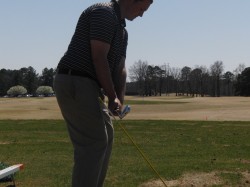Putting and Rhythm
Wednesday, March 16th, 2011What is rhythm? How do I obtain it? Can it be taught? The answer is yes! Just as in all aspects of the golf stroke (putting and full swing) the answer is not only soluble, but easily attainable as well. The mystery dissolves with a closer look at perhaps the most overlooked axiom in the stroke, the dynamics. More simply put, dynamics in putting refers to the motion and time it takes the putter to travel. The average rhythm of putting strokes on the PGA tour takes approximately twice the time on the backswing as it does to impact. The actual time may vary between each player, much like a signature, but the ratio stays at approximately 2:1. When working with the dynamics of the stroke, you can actually improve someones “touch” without the repetitiveness of hitting hundreds or thousands of putts! “Touch” infers the ability to consistently produce a high precision movement of the putter to roll the ball a particular distance, which is vital for producing the correct delivery speed for the ball to enter the hole . Struggling with the yips? Poor dyanmics lead to erratic face and distance control issus, especially on those short putts!
Here is an example of a “yip” stroke
Here is an example of improved dynamics and better ratio
To improve your dynamics today, make a practice stroke and count “one…two” during your natural backswing (no matter how fast or slow that may be) and “one” during from the end of the backstroke to where impact would be (no ball yet remember). The speed of the count will be different for each individual; faster or slower depending on your natural tendency; the goal being to acheive a backswing length roughly twice as long as the downswing to impact. Once you can get into a consistent rhythm and have timed it out, then you may try it stroking a ball to a target with the same count; “one…two…one”!


